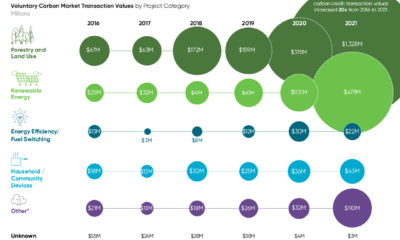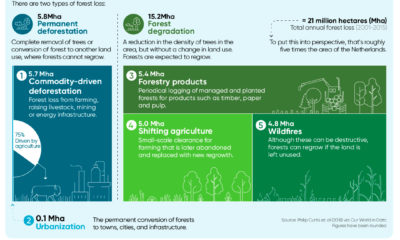In spite of these dangers, methane abatement receives a fraction of all climate financing. Based on an analysis from the Climate Policy Initiative, $110 billion in funding is needed annually, or about tenfold the amount spent today. This infographic sponsored by Carbon Streaming Corporation looks at the benefits of mitigating methane emissions across key sectors.
The Benefits of Reducing Methane Emissions
The risk of methane emissions is substantial: it has contributed to nearly half of net global warming.
The good news is that future emissions can be cut significantly. Methane solutions that are currently available, combined with additional measures that target priority development goals, can cut 45% of human-caused methane emissions by 2030, equivalent to about 180 million tonnes per year (Mt/yr).
This translates into 0.28°C in avoided warming between 2040 and 2070 along with 255,000 premature deaths being avoided due to rising ozone concentrations.
Source: UN Environment Programme
On top of this, 26 million tonnes of crop losses could be avoided each year—equal to about 10% of America’s total food production annually—by utilizing these combined reduction measures.
Methane Mitigation Potential by Sector
As a noxious greenhouse gas, methane is often found in livestock emissions, landfills, and natural gas. For these reasons, the agricultural, waste, and fossil fuel sectors produce the most methane emissions annually. Where do the largest opportunities lie in mitigating emissions?
Waste
The waste sector presents an opportunity to reduce 29-36 million tonnes of methane emissions annually. The vast majority—80% of landfill emissions and 70% of wastewater methane emissions—can potentially be mitigated by 2030 with technologies that are technically feasible today.
Agriculture
By 2030, 30 million tonnes of methane emissions have the potential to be removed each year in the agricultural sector. In fact, 30% of livestock emissions can be potentially eliminated in a technically feasible way over this time period.
Fossil Fuels
The highest potential is found in fossil fuels, with up to 57 million tonnes of methane emissions from the oil and gas sector and up to 25 million tonnes from the coal sector having the potential to be mitigated each year by 2030. Research shows that up to 80% of targeted measures in the oil and gas sector and up to 98% of coal measures could be implemented at negative or low cost. In particular, methane leak detection and repair in the oil and gas industry represent a significant opportunity. For instance, between 2019 and 2021, over 2,400 large methane leaks took place.
Significant Potential
Today, technologies to fight methane emissions are readily available, with the potential for immediate benefits.
Consider how 0.1°C in warming could be prevented by 2050 using methane abatement technologies in the oil and gas sector. This is equivalent to eliminating the entire emissions of road vehicles—from cars to two-wheelers—globally.
Given the grave threat methane emissions pose to the planet and society, methane abatement solutions present significant opportunities using current technologies.
Carbon Streaming supports mitigating methane emissions with its carbon credit streams on projects in Canada and India.
Source: UN Environment Programme, ‘Global Methane Assessment: Benefits and Costs of Mitigating Methane Emissions’ (May 2021)
on
Today’s connected cars come stocked with as many as 200 onboard sensors, tracking everything from engine temperature to seatbelt status. And all those sensors create reams of data, which will increase exponentially as the autonomous driving revolution gathers pace.
With carmakers planning on uploading 50-70% of that data, this has serious implications for policymakers, manufacturers, and local network infrastructure.
In this visualization from our sponsor Global X ETFs, we ask the question: will connected cars break the internet?
Data is a Plural Noun
Just how much data could it possibly be? There are lots of estimates out there, from as much as 450 TB per day for robotaxis, to as little as 0.383 TB per hour for a minimally connected car. This visualization adds up the outputs from sensors found in a typical connected car of the future, with at least some self-driving capabilities. The focus is on the kinds of sensors that an automated vehicle might use, because these are the data hogs. Sensors like the one that turns on your check-oil-light probably doesn’t produce that much data. But a 4K camera at 30 frames a second, on the other hand, produces 5.4 TB per hour. All together, you could have somewhere between 1.4 TB and 19 TB per hour. Given that U.S. drivers spend 17,600 minutes driving per year, a vehicle could produce between 380 and 5,100 TB every year. To put that upper range into perspective, the largest commercially available computer storage—the 100 TB SSD Exadrive from Nimbus—would be full in 5 hours. A standard Blu-ray disc (50 GB) would be full in under 2 seconds.
Lag is a Drag
The problem is twofold. In the first place, the internet is better at downloading than uploading. And this makes sense when you think about it. How often are you uploading a video, versus downloading or streaming one? Average global mobile download speeds were 30.78 MB/s in July 2022, against 8.55 MB/s for uploads. Fixed broadband is much higher of course, but no one is suggesting that you connect really, really long network cables to moving vehicles.
Ultimately, there isn’t enough bandwidth to go around. Consider the types of data traffic that a connected car could produce:
Vehicle-to-vehicle (V2V) Vehicle-to-grid (V2G) Vehicles-to-people (V2P) Vehicles-to-infrastructure (V2I) Vehicles-to-everything (V2E)
The network just won’t be able to handle it.
Moreover, lag needs to be relatively non-existent for roads to be safe. If a traffic camera detects that another car has run a red light and is about to t-bone you, that message needs to get to you right now, not in a few seconds.
Full to the Gunwales
The second problem is storage. Just where is all this data supposed to go? In 2021, total global data storage capacity was 8 zettabytes (ZB) and is set to double to 16 ZB by 2025.
One study predicted that connected cars could be producing up to 10 exabytes per month, a thousand-fold increase over current data volumes.
At that rate, 8 ZB will be full in 2.2 years, which seems like a long time until you consider that we still need a place to put the rest of our data too.
At the Bleeding Edge
Fortunately, not all of that data needs to be uploaded. As already noted, automakers are only interested in uploading some of that. Also, privacy legislation in some jurisdictions may not allow highly personal data, like a car’s exact location, to be shared with manufacturers.
Uploading could also move to off-peak hours to even out demand on network infrastructure. Plug in your EV at the end of the day to charge, and upload data in the evening, when network traffic is down. This would be good for maintenance logs, but less useful for the kind of real-time data discussed above.
For that, Edge Computing could hold the answer. The Automotive Edge Computing Consortium has a plan for a next generation network based on distributed computing on localized networks. Storage and computing resources stay closer to the data source—the connected car—to improve response times and reduce bandwidth loads.
Invest in the Future of Road Transport
By 2030, 95% of new vehicles sold will be connected vehicles, up from 50% today, and companies are racing to meet the challenge, creating investing opportunities.
Learn more about the Global X Autonomous & Electric Vehicles ETF (DRIV). It provides exposure to companies involved in the development of autonomous vehicles, EVs, and EV components and materials.
And be sure to read about how experiential technologies like Edge Computing are driving change in road transport in Charting Disruption. This joint report by Global X ETFs and the Wall Street Journal is also available as a downloadable PDF.












